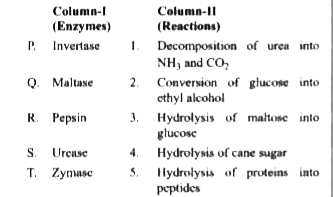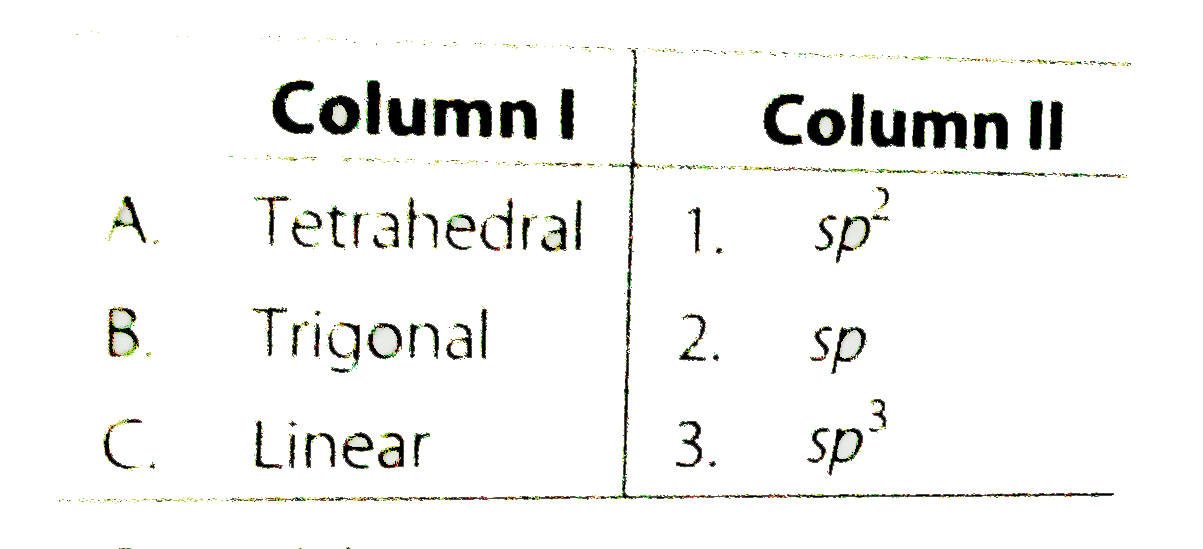Match the following enzymes given in Column I with the reactions they catalyse given in Column II.
ColumnI(Enzymes)ColumnII(Reactions)A.Invertase1.Decomposition of urea intoNH3andCO2B.Maltase2.Conversion of glucose into enthyl alcoholC.Pepsin3.Hydrolysis of maltose into glucoseD.Urease4.Hydrolysis of cane sugarE.Zymase5.Hydrolysis of proteins into peptides
The correct Answer is:A, B, C, D
Step by step video, text & image solution for Match the following enzymes given in Column I with the reactions they catalyse given in Column II. {:(Column I("Enzymes"),Column II("Reactions")),(A."Invertase",1."Decomposition of urea into" NH_(3)and CO_(2)),(B."Maltase",2."Conversion of glucose into enthyl alcohol"),(C."Pepsin",3."Hydrolysis of maltose into glucose"),(D."Urease",4."Hydrolysis of cane sugar"),(E."Zymase",5."Hydrolysis of proteins into peptides"):} by Chemistry experts to help you in doubts & scoring excellent marks in Class 12 exams.
Updated on:21/07/2023Topper's Solved these Questions
- BIOMOLECULESBOOK - DINESH PUBLICATIONCHAPTER - BIOMOLECULESEXERCISE - ASSIGNMENT
79 Videos
- BIOMOLECULESBOOK - DINESH PUBLICATIONCHAPTER - BIOMOLECULESEXERCISE - TARGET
60 Videos
- BIOMOLECULESBOOK - DINESH PUBLICATIONCHAPTER - BIOMOLECULESEXERCISE - HIGHER ORDER THINKING SKILLS (HOTS) QUESTIONS
13 Videos
- BASIC PRINCIPLES OF ORGANIC CHEMISTRYBOOK - DINESH PUBLICATIONCHAPTER - BASIC PRINCIPLES OF ORGANIC CHEMISTRYEXERCISE - Matrix Type Questions
2 Videos
- CARBOXYLIC ACIDS BOOK - DINESH PUBLICATIONCHAPTER - CARBOXYLIC ACIDS EXERCISE - BRAIN STORMING MULTIPLE CHOICE QUESTIONS (MCQS)
13 Videos
Similar Questions
Match the types of colloidal systems given in Column I with the name given in Column II.
Column IColumn IIA.Solid in liquid1.FoamB.Liquid in solid 2.SolC.Liquid in liquid 3.GelD.Gas in liquid4.Emulsion
View SolutionMatch the items given in Column 1 with examples give in Column II.
Column IColumn II(a)Hydrogen bond(i)C(b)Resonance(ii)LiF(c)Ionic solid(iii)H2(d)Covalent solid(iv)HF(v)O3
View Solution
Knowledge Check
Match the enzymes given in column I with their catalytic reaction given in column II and select the correct answer.
 AP-4,Q-3, R-5, S-1, T-2BP-2, Q-5, R-4, S-3, T-1CP-4,Q-3, R-1, S-2, T-5DP-5, Q-1,R-3, S-4,T-2
AP-4,Q-3, R-5, S-1, T-2BP-2, Q-5, R-4, S-3, T-1CP-4,Q-3, R-1, S-2, T-5DP-5, Q-1,R-3, S-4,T-2Match the elements given in column (I) with the most appropriat expected values given in column II
Column IColumn IIElementElectronegative valuesA.F(p)3.5B.O(q)3.0C.N(r)4.0D.C(s)2.5AA(r ), B(p),C(q),D(s)BA(s),B(q),C(r ),D(p)CA(p),B(q),C(r ),D(s)DA(r ),B(q), C(p),D(s)
Match the conversions in Column I with the type(s) of reaction(s) given in Column II.
Column IColumnIIA.PbS→PbOp.RoastingB.CaCo3→CaOq.CalcinationC.ZnS→Znr.Carbon reductionD.Cu2S→Cus.Self-reduction
View SolutionMatch the items given in Column I with examples given in Column II.

View SolutionMatch the enzymes given in column I with the substrates they act upon in column II and the product obtained from the reaction given in column III and select the correct. Option from the codes given below .

View SolutionMatch the shape of molecules in Column I with the type of hybridisation in Column II.

View SolutionMatch the shape of molecules in Column 1 with the type of hybridisation in Column II.
Column IColumn II(a)Tetrahedral(i)sp2(b)Trigonal(ii)sp(c)Linear(iii)sp3(d)Trigonal bipyramidal(iv)sp3d
View SolutionMatch the column :
Column IColumn II(A). Sucrose(P). Two acetals(B). Maltose(Q). No hemiacetal(C). Lactose(R). β−1,4'−glycosidic bond(D). Cellulose(S). Hydrolysis product is glucose
View Solution
